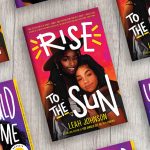As a parent of a child who seemed to be born loving trains, I’ve learned more about trains than I ever imagined I would in one lifetime. Though he’s now matured well beyond wooden toy railways and cartoons, his locomotive interests have stretched into realms I also never expected. As a 5th grader, he is intrigued by the history of train travel, he researches train wrecks and their effects on railway safety, he learns about famous trains of the past and present, and he also contemplates the future of train travel and how it can be developed. We love to read, so we’ve also flipped the pages of our fair share of literature featuring trains, including all the famous titles you know and love. Most recently, we enjoyed The Silver Arrow by Lev Grossman, which I highly recommend for an upper-elementary read-aloud, a first chapter share, and for your classroom libraries. It is a humorous fantasy with an environmental theme (i.e., The Lorax) and is now one of my favorite books of all time.
This summer we made our semi-annual stop at the National Railroad Museum in Green Bay, WI. One of the exhibits was about famous Black Americans who were Pullman porters from the post-Civil War era to the civil rights era, and it suddenly became clear to me just how rich the topic of trains can be. I’m so impressed by the vast knowledge my son has soaked up, just because he loves trains.
As a former teacher, I realized this one topic of trains could cover so much ground in the classroom. True, the topic of “trains” does not appear on the standards you’re striving to meet in your classrooms, but what if you chose several high-interest topics as a school (or grade level) and built cross-curriculum connections to those topics? Teachers are already so skilled at finding those niche interests our students enjoy, and using them to find connections to our curriculum, we could take those even further to really celebrate those interests schoolwide.
Go deep into the train tunnel with me to see how rich and diverse the learning opportunities can be with this one topic of trains.
Imagine the whole 5th grade is doing a cross-curricular unit with a theme of trains:
- Language Arts: conduct an adventure-themed book club with these fiction selections: The Silver Arrow (Grossman), Runaway (Barker), On the Blue Comet (Wells), Boundless (Oppell), Train to Impossible Places #1 (Bell), Lantern Sam and the Blue Streak Bandits (Biel)
- Science: research the environmental impact of steam engines, coal, and fossil fuels; clean energy as it relates to train transport
- Math: study geometry and angles with famous train station architecture (like King’s Cross) or trains
- Art: create a model train layout, and practice drawing trains at different model train scales (1:25 all the way down to 1:220)
- STEAM: tinker with engineering marvels like maglev trains, high-speed trains, and underwater tunnels
- Social Studies: the building of the Transcontinental Railroad
- Music: listen to, play, or sing traditional folk railroad songs and ballads, like “The Ballad of John Henry,” and study how a train whistle blows and compare to other wind instruments
- Physical Education: swing dance to “Chattanooga Choo Choo”
If that doesn’t get your wheels turning, see more ideas for cross-curricular connections to trains below. Then, don’t forget to scroll down to see a list of great books about trains to reach all grade levels (K-12).
More Cross-Curricular Connections:
- Transport of orphans on “Orphan Trains”
- Pullman porters and Black history, post-Civil War (as mentioned above)
- Industrial Revolution and the steam engine
- Transcontinental Railroad: so much drama! Don’t forget the oft-unrecognized work of thousands of Chinese immigrants
- The Gold Rush
- American Railway Union: the first industrial union in the U.S.
- Farming and transportation of goods by train
- Major figures in train history: Cornelius Vanderbilt, John D. Rockefeller, E.H. Harriman, James J. Hill, Jay Gould
- Impact of personal automobiles and flight on the railroad industry
- Women on the railroad, featured in Iron Women: The Ladies Who Helped Build the Railroad (Enss) and Female Railway Workers in WWII (Major)
- “Mailing” children by train in the early 1900s
- The Great Depression
- Circus trains – Ringling Bros, Barnum & Bailey, and others
- Life and times of a train engineer, past and present
- Modern use of trains for manufacturing, shipping, military, and trade
- Cultural differences in the use of trains/public transportation
- Economics and efficiency of travel by train
- Model Railroading – a unique hobby where you can learn about scale, texture, casting, carving, modeling, electrical currents, landscape, and topography all in one hobby
- STEAM: engineering, design, aerodynamics, electricity, steam energy, engines, magnetic forces, friction, pushing and pulling forces
- Architecture and design for form and function, including famous train stations
- Future of mass transit using trains
- Famous animals like those featured in the books Bob the Railway Dog (Fenton), or Blind Tom: The Horse Who Helped Build the Great Railroad (Redmond)
- Read-alouds to enjoy or to study poetic or literary elements: How to Train Your Train (Eaton), Secret Subway (Corey), The Little Engine Who Could (Piper), Locomotive (Floca), Snakes on the Train (Dennis), Goodnight Train (Sobel), and Steam Train Dream Train (Rinker), Two Little Trains (Brown), and Caboose Who Got Loose (Peet)






